Something something something new series. I’m going to be looking at one game each week, taking each quarterbacks’ top three most impactful non-scoring plays (via EPA, expected points added), and breaking down said plays. The point is to illustrate how game-swinging plays happen by exploring how defenses attack an offense, how a quarterback handles that attack, and how much help in game-swinging moments a quarterback is getting from their teammates. Honestly, I don’t know what I hope to learn or gain from this series, but I wanted something to keep busy. This is more of a stream of consciousness than anything.
Dallas Cowboys @ Los Angeles Rams, Rams win 20-17
Jared Goff, Los Angeles Rams
3rd quarter 5:59, 3rd-and-3, DAL 19-yard line — 17-yard gain to Josh Reynolds (3.17 EPA)
This third down connection to Reynolds was the highest EPA non-scoring play of the game. In fact, only Ezekiel Elliot’s receiving touchdown in which he made half the Rams defense miss a tackle earned more EPA on a single play (barely).
The Rams start in a trips-right bunch formation before shifting tight end Tyler Higbee (89) to a wing position on the left. Dallas responds by spinning their safeties, pushing the original deep safety down to the curl/flat area over the wing while the other safety replaces him in the deep middle portion of the field. Goff can assume the Cowboys spin down the safety to maintain two-on-two coverage numbers over the wing tight end and the running back, which suggests Dallas isn’t dropping the edge rusher (Aldon Smith, 58) to that side of the field into coverage.
What’s left for Goff to determine at this point is whether Jaylon Smith (54), who is over the right tackle, is actually rushing the passer or if he is going to drop into coverage. If he were to drop into coverage, the most likely assignment would be for him to be a hook play, as the outside cornerback would take a deep 1/3rd and the nickel would fly to the flat. In turn, the middle linebacker would take the opposite and the safety who rolled down would handle the flat. The play is 3rd-and-7, though, and Goff does not want to take the risk in guessing that Smith isn’t a rusher. Goff’s priority then becomes getting the ball out to the sticks as quickly as possible while assuming Smith is coming as a fifth rusher.
Goff takes the snap, eyeballs the deep safety, then rips a pass straight to Reynolds upon settling at the top of his drop back. At no point does Goff hesitate or aim to throw the ball elsewhere — he knows the ball has to be out. Goff’s pass is perfectly placed just a hair low and away, putting it in the trickiest spot for the defensive back to get to. By all accounts, this is wonderful coverage by the cornerback, but Goff’s accuracy overrides that and gives the Rams the conversion.
This seemingly unspectacular play was a game-changer in large part because of down-and-distance paired with the move from field goal range to near-assured touchdown range.
2nd quarter 3:52, 3rd-and-5, Rams 48 — 33-yard gain to Van Jefferson (2.95 EPA)
As far as positive plays go, the deep ball to Van Jefferson is the one we all remember. Goff can flash some truly phenomenal ball placement when kept clean enough to do so. He reminded us why, even if he is an imperfect player, the Rams decided to pay him like one of the best.
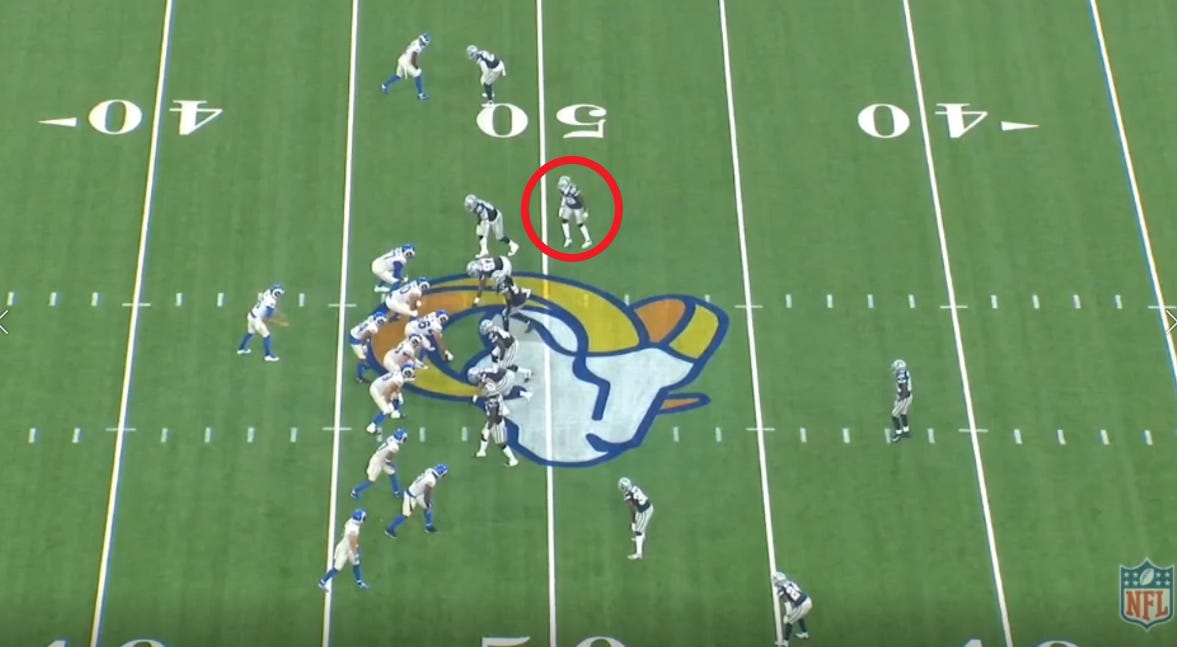
So, let’s start with this pre-snap frame. Look at the defensive back circled in red. Who the hell is he going to cover? The Rams just motioned their slot receiver from left to right, leaving a lone receiver split out wide to the left versus a trips set on the right. If the running back were in a normal alignment to the quarterback’s left, perhaps that defensive back could be on him, but the back is walked up to the line as a sniffer. The back is a blocker, no doubt about it.
Goff knows that the defensive back “has to” blitz, which is why you will see him give a call out to the offensive line once he sees the defensive back is still down low, likely calling for the line to half-slide left. Goff may not know who else is coming, but he confirms the one blitzer and changes gears to “grip it and rip it” mode.
The Cowboys have seven dudes across the line of scrimmage and Goff already knows one of them is almost certainly blitzing off the left side. For him to think he is going to get the time to read the trips side of the field would be greedy. Goff takes the snap, holds the safety for as long as he can (even though that deep safety likely ain’t making it there anyway), and layers one right over Jefferson’s outside shoulder away from the cornerback.
Aside from simply being a massive gain, this play earned a high EPA rating for vaulting the Rams from well outside of field goal range into field goal range in an instant — on a third down, no less. Granted, a 40-ish yard field goal isn’t exactly a freebie, but it’s a hell of a lot better than being deep into punting range.
3rd Quarter 3:58, 3rd-and-7, Rams 30-yard line — Interception (-2.88 EPA)
I know, I know. This play should have been a roughing-the-passer call on Aldon Smith. Smith clearly got his hand across Goff’s facemask and nearly spun it all the way around. I’m not convinced Goff getting hit the way he did is the sole reason for this interception, though. Goff might have been picked off whether Smith committed an unpunished penalty or not.
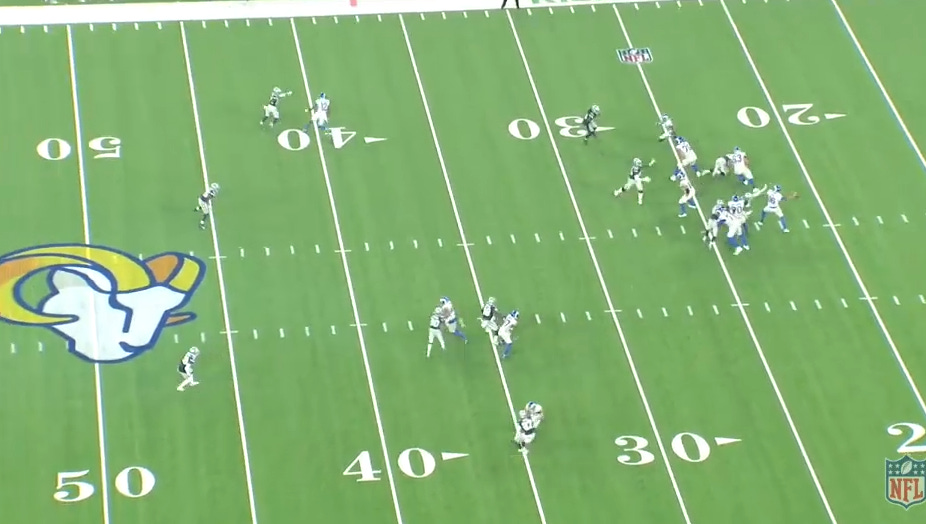
Here is the still shot as Goff’s arm is coming around and right before Smith gets a hand on him. Cornerback Chidobe Awuzie isn’t exactly in “pick this off 10 times out of 10” territory, but he is well within reach of the assumed catch point that he is going to be making a play on this ball. Goff’s best bet would be a low, away throw that the receiver has to dig off the dirt, but even that feels terribly low-percentage with as well as Awuzie is going to be able to contest it.
The real kicker, to me, is whatever is going on between the running back and Smith.
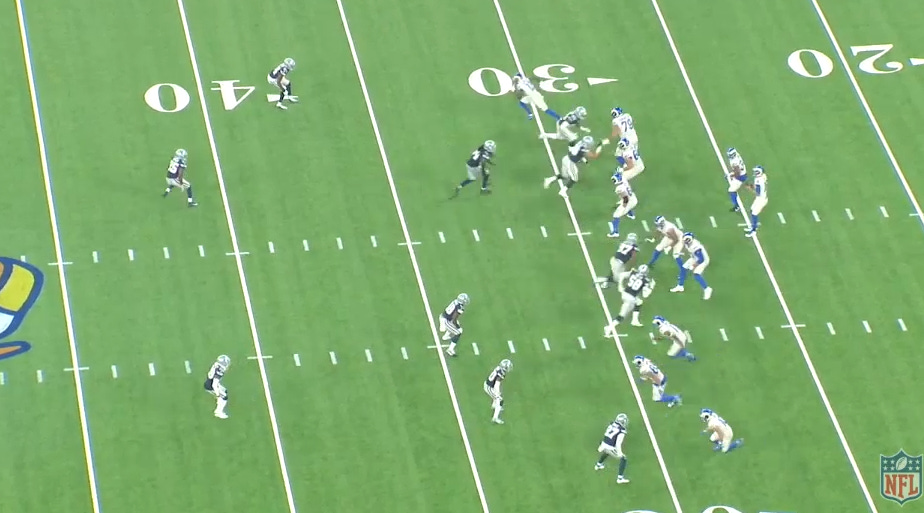
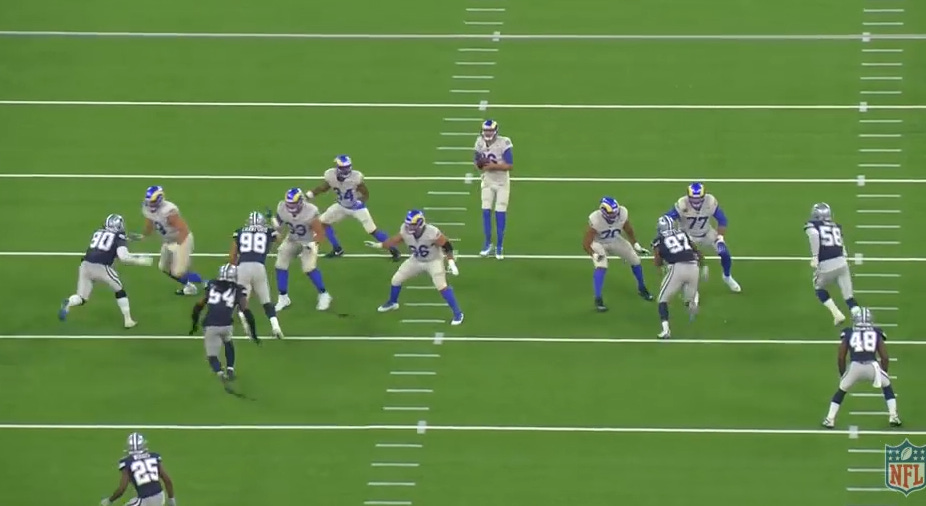
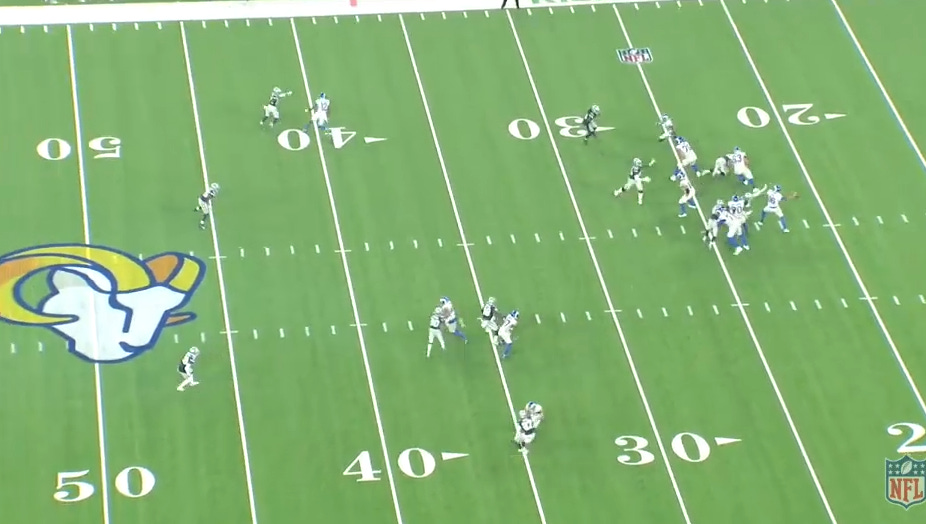
In these couple of stills, you can see the running back take a delayed shuffle out of the backfield as he keeps his eyes on Smith. My best guess is that this is a particular/specific “check release” that is conditional on things like it being third down and potential tendencies the Rams saw in the Cowboys’ fronts. I don’t know shit, honestly, so I’m mostly making this up. But it’s tough for me to imagine what else the back is doing here, especially considering Smith’s eyes and feet match perfectly with the theory.
I don’t need to explain why this one had a high EPA swing. It’s a turnover. In your own team’s territory. Awful.
Dak Prescott, Dallas Cowboys
2nd Quarter 0:45, 2nd-and-11, LAR 13-yard line — 12-yard run (3.03 EPA)
In terms of skill expression, this was not Prescott’s best play of the night. Far from it, I’d say. However, since the gain catapulted the Cowboys into near-assured touchdown range, it’s not hard to understand why this play was so valuable.
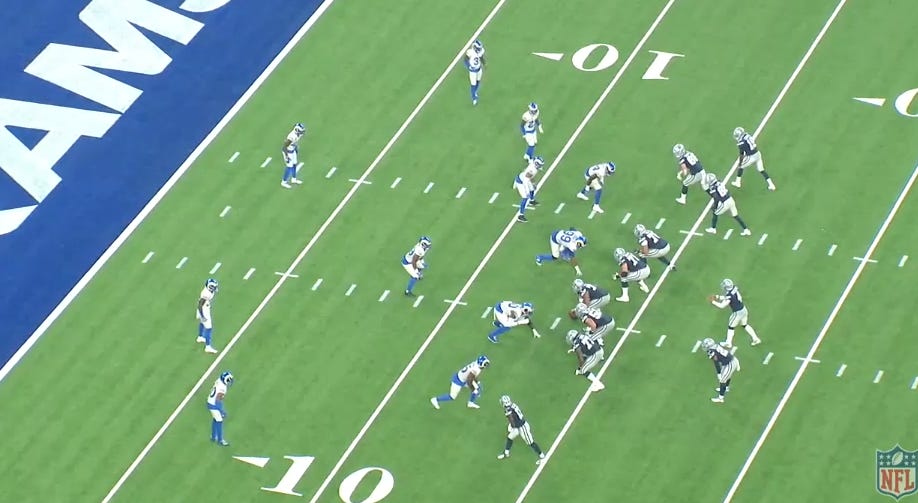
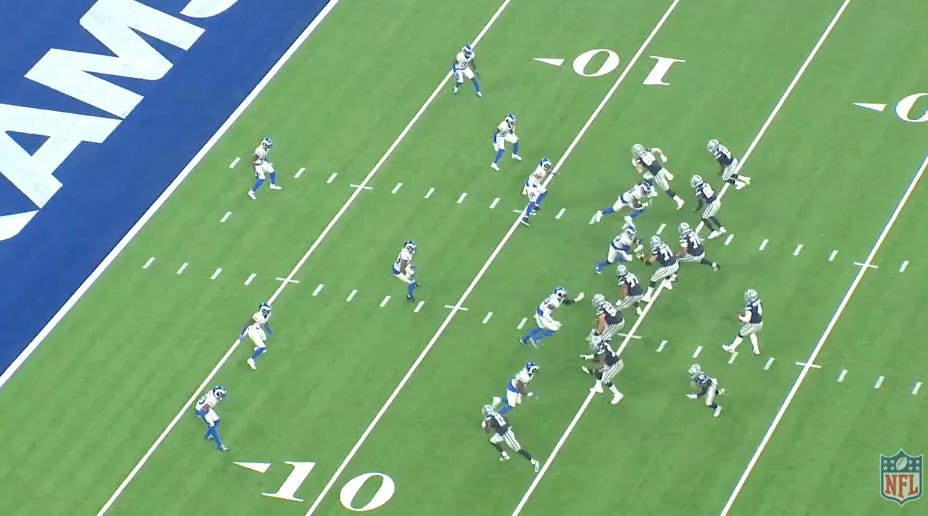
Let’s start with some screencaps right before and after the snap. The Rams spin their weak safety down at the snap while the strong safety slides towards the middle of the field. New Rams defensive coordinator Brandon Staley called the defense like this all game, so it’s no surprise that it shows up in one of these plays. With both outside cornerbacks playing seven or so yards off, as soon as Prescott catches the safety rotation, he should have a strong inkling that the Rams are in Cover 3.
Prescott opens to the swing from the back, but catches the safety spinning down and knows that’s a no-go. He then resets and directs his eyes towards the glance/short bender from Michael Gallup (13), but the receiver has yet to make his break and the linebacker, who has no responsibility to fly down to the back in the flat, is still in the throwing window. By the time Prescott gets back to the incoming shallow crosser on this triangle read, it seems as though he believes the incoming crosser is already too close to the linebacker over the left hash for this throw to be worthwhile. Rather than ride the concept to its bitter end and rifle the ball in anyway, Prescott slides up, pumps the shallow to hold the linebacker for a second, and races for the goal line. Not the flashiest play, but those are the ones that keep teams in games.
4th Quarter 11:46, 4th-and-3, LAR 11-yard line — 2-yard gain to CeeDee Lamb (-2.42 EPA)
Full disclosure: Prescott actually had a play with slightly worse EPA than this, but I threw it out because I didn’t think it would teach us anything. It was the 4th-and-20 at the very end of the game, so, yeah, of course the EPA on a non-conversion there was terrible. It’s just not a play worth exploring. Anyway, onto the play at hand.
Had the Cowboys converted on this play, they would have earned a fresh set of downs inside the 10-yard line. That isn’t quite a guarantee for a touchdown, but with as talented as the offense is, it would be a damn good bet. Unfortunately for Dallas, Rams rookie Jordan Fuller made an outrageous play off a coverage switch on this play.
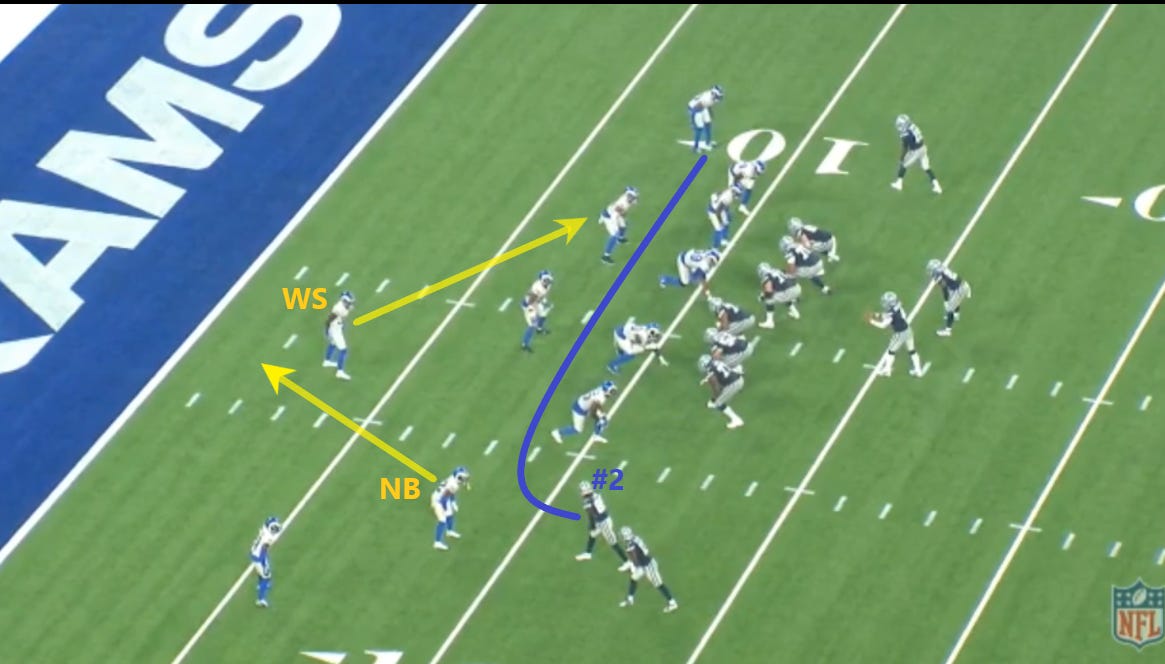
As far as I can tell, Los Angeles’ weak safety and nickel cornerback are playing off of whether the #2 (inside) wide receiver is “under” right away. If he is “under” right away, the weak safety plays it from over the top and drives towards the other side of the field, rather than having the nickel chase from behind. The nickel then replaces the weak safety in the middle of the field, where the weak safety looks to be assigned if the #2 were not “under” right away.
Prescott wants the wheel route at first, but the Rams’ defender does a wonderful job of flying to the flat and staying over the top of the wheel. No dice there for Prescott. He then directs his eyes to the tight end hooking right at the sticks. The tight end himself is covered, but from Prescott’s point of view, the area is heavily congested and Lamb should be able to fly right past the traffic into the open field. Prescott takes that mental image and puts one on Lamb just before the numbers. Fuller, the safety, makes an unreal play, though, and takes down Lamb before he really gets a chance to turn up the field and run.
Honestly, it’s difficult to figure out what more Prescott could have done. The ball was out at a reasonable time and the ball was plenty catchable. Perhaps if Prescott kept this throw at chest level and a smidgen more in front, Lamb would have had an easier time converting himself into a runner, but Fuller was in a perfect spot to defend this regardless. The Rams had the right built-in answer to Dallas’ plan of attack and Fuller made an excellent play on the ball. Happens.
2nd Q, 13:30, 1st/10 — 33 yard gain to CeeDee Lamb (2.18 EPA)
This is the throw all of us remember. Aside from it being a wonderful throw, it’s easy to remember because the Cowboys didn’t really generate any other explosive plays on the day. Prescott only had one other attempt beyond 15 yards, which was a failed deep ball down the left sideline on the last play of the game.
Once again, the Rams roll down their boundary safety at the snap to create a one-high shell. With the boundary cornerback playing off before the snap, Prescott should again have an idea that some form of Cover 3 is coming. Once the ball is snapped and Prescott confirms #50 is coming off the edge, Prescott should really be ready for some Cover 3. If the Rams are sending five rushers, though, either a Fire Zone or man free coverage is your best guess here.
Prescott takes that information and immediately slides to the right, where Lamb is heading towards. Deep crossers from Cover 3 can either be handled by the cornerback following the crosser, the deep safety nailing down from the middle of the field, or the opposite cornerback falling off the post to sit where the crosser is headed to, depending on the call and a particular defense’s philosophy or built-in adjustments. The opposite cornerback was pressed up at the snap, though, so the likelihood that he is going to be falling off is quite small. That leaves either the initial cornerback to follow or the deep safety nailing down. The boundary cornerback sloughs off and becomes a MoF defender, though, so it’s all on the safety to get to this one.
In this instance, the deep post from the right side helped create traffic in the deep safety’s path down towards the crosser, so Prescott mostly just had to keep the ball over the top of the nickel defender who sank into coverage over the right hash in this Fire Zone Cover 3. That Prescott could so fluidly piece together this information, slide to open grass, and deliver a perfect ball while getting hit is a testament to how complete a quarterback he has become.
Well, that’s the first installment of this EPA-based series that I still don’t have a name for. It was fun to put some of the game’s most influential plays in context and look at why some of them worked (or didn’t). If I continue to have fun with these and have the time for ‘em, I’ll probably keep doing it.











